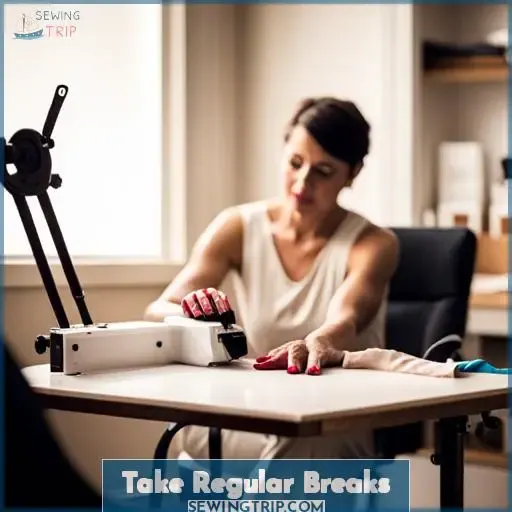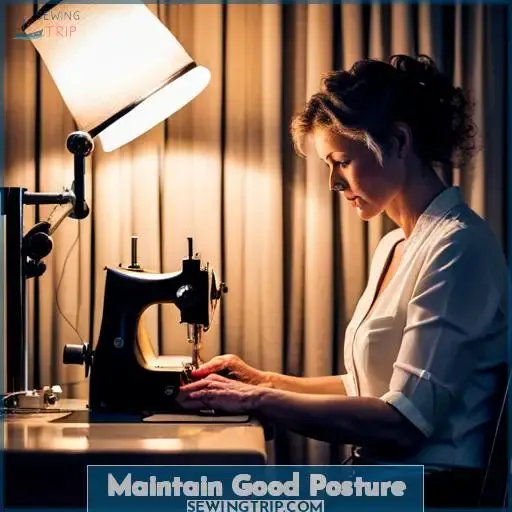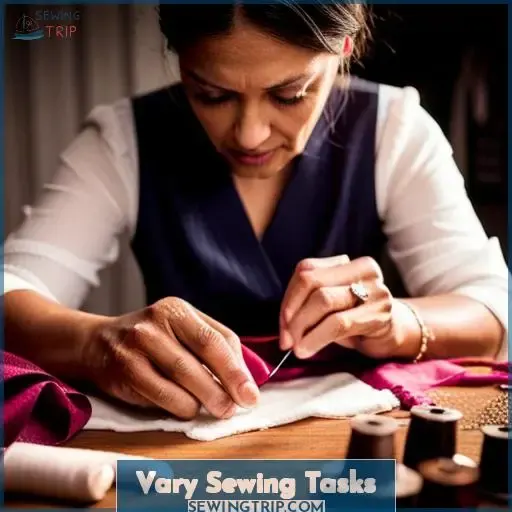This site is supported by our readers. We may earn a commission, at no cost to you, if you purchase through links.

back muscles knotting like tangled thread,
consider this:
Proper posture and thoughtful ergonomics
will liberate you from pain’s snare.
Let’s reshape your space for comfort’s sake,
aligning spine, cushioning seat,
taking thoughtful breaks to walk and stretch cramped limbs.
Together we’ll create an oasis amid fabric
where creativity flows freely once more.
Table Of Contents
Key Takeaways
- Adjust your chair height so your thighs are parallel to the floor and your feet are flat.
- Use a supportive back cushion or lumbar support to maintain proper spinal alignment.
- Take regular breaks to stand, stretch, and walk around to relieve muscle tension.
- Maintain good posture by sitting up straight and avoiding hunching over. Strengthen core muscles through exercises.
Adjust Sewing Area Ergonomics
When setting up your sewing area, prioritize proper chair height and back support.
Sit on a cushion that supports the natural curve of your spine, or consider adding a detachable back cushion to your existing chair.
Having the right chair height and back support are crucial first steps to prevent back pain while sewing.
Proper Chair Height
Adjust your chair height so your thighs are parallel to the floor and feet are flat when seated at your sewing machine.
Sit with a 90-90-90 degree posture – hips, knees, and ankles at 90-degree angles.
Adjust chair height so forearms are parallel to the floor.
Use a footrest if feet don’t touch the floor.
Add a lumbar support cushion to align the natural curve of the lower back.
Periodically stand up to give back muscles a break.
Supportive Back Cushion
One thing you’ll want is a supportive back cushion on your sewing chair to help maintain proper spinal alignment.
Adding an ergonomic backrest provides essential lumbar support to prevent slouching and strain.
Consider cushions with adjustable straps or removable inserts to customize the fit and support level for your back.
Having adequate backrest options helps engage your abdominal muscles for good posture, reducing discomfort so you can sew comfortably.
Take Regular Breaks
You’ll want to take frequent short breaks while sewing.
Get up, gently stretch your back, neck, and shoulders, and take a quick walk around the room.
This will relieve muscle tension that builds up from maintaining static postures.
Stretching
By taking short breaks for some simple stretches, you’ll relieve muscle tension and prevent back pain from prolonged sitting.
Try a few minutes of mindful stretching or quick desk yoga workouts when you start feeling tension build up.
Simple moves like neck rolls, shoulder shrugs, toe touches, and upper back twists can refresh muscles.
Brief active breaks help circulation, flexibility, and posture, keeping you energized and focused when returning to your project.
Applying a few basic office stretches prevents fatigue, strains, and back discomfort from hunching over sewing tasks all day.
Short Walks
You’ll want to take short walks during your regular breaks from sewing to relieve muscle tension.
Even just walking around your sewing room or taking a quick stroll outside can help relax your back and shoulder muscles.
Use these brief walk breaks to gently stretch your neck, shoulders, and back too.
Simple ergonomic stretches while standing can offset the strain of sitting.
This posture check lets you reset alignment before more sewing.
Varying tasks also prevents repetitive stress.
Listen to your body and take a walk when discomfort arises.
Maintain Good Posture
You’ll want to support your lower back properly while sewing to avoid strain.
Make sure to align your spine by sitting up straight rather than hunching over.
Using a back cushion can help reinforce good posture if you find your back muscles getting tired.
Support Lower Back
You can support your lower back while sewing by using a small pillow or cushion to help maintain the natural curvature of your spine.
Here are four tips for supporting your lower back and maintaining good posture:
- Use a lumbar support or back cushion to provide extra support and prevent slouching.
- Strengthen your core muscles through exercises like planks and bridges to improve stability in the lower back.
- Take regular breaks from sewing to stretch out tight ham-string muscles and relieve tension in the lower back.
- Sit on an ergonomic chair with proper height adjustment, ensuring that your feet are flat on the ground for optimal posture.
By following these tips, you can reduce discomfort and prevent future pain while enjoying your sewing projects.
Align Spine
While supporting your lower back is crucial for good posture, you also need to keep your spine properly aligned when sewing to avoid back pain.
As you sit at your sewing station, be mindful to align your spine by envisioning a straight line passing through your ears, shoulders, and hips.
Engaging core muscles with basic posture exercises helps reinforce proper spinal alignment.
Consider using back support cushions or taking occasional stretch breaks to realign posture.
Keeping your spine aligned this way reduces strain that contributes to discomfort.
Vary Sewing Tasks
After maintaining good posture, alternate between tasks like cutting fabric, ironing seams, and sewing at the machine.
Rotating between different sewing activities prevents fatigue and strain from repetitive motions.
Take breaks to cut fabric using proper technique – stand with feet shoulder-width apart on a supportive mat.
Or give your back a rest by gently ironing seams. The heat may even relieve muscle tension.
Then return to sewing refreshed, utilizing good posture.
Varying your tasks allows certain muscle groups to rest while you engage others.
This diversity reduces injury risk and helps you sew comfortably for longer periods.
Whether ripping seams, pinning pieces, or machine sewing, listen to your body and switch tasks when you feel tension building up.
Task rotation is an essential ergonomic practice for avoiding hazards like back pain while sewing.
Strengthen Core Muscles
After varying your sewing tasks, remember to regularly strengthen your core.
Having solid core strength supports good posture while sewing and prevents back strain.
Make core exercises part of your self-care routine.
Simple moves like planks, crunches, and Pilates rotations boost core muscles.
As you build strength, challenge yourself with balancing postures like tree pose from yoga.
When the core stabilizes the spine, pressure lifts off the back.
Complement sewing with even 10 minutes a day of intentional core toning.
As muscles strengthen, you feel centered while sewing.
Liberate tight spots through breath and movement.
Serve your body well so you can keep creating.
When we understand how posture and core fitness intertwine, we sew better.
Frequently Asked Questions (FAQs)
What type of chair is best for sewing to prevent back pain?
Use an adjustable chair with good lumbar support, firm cushioning, armrests, and a tilted seat.
This allows tailoring the chair specifically for you to maintain proper spinal alignment and reduce strain while sewing.
Periodically stand up, stretch, and walk around to give your back muscles a break.
Should I consider a standing desk for sewing to avoid sitting for too long?
Yes, consider using a standing desk while sewing.
This allows you to alternate between sitting and standing, reducing prolonged static positions that can cause muscle fatigue and pain.
Make sure to still take regular movement breaks when using a standing desk.
Listening to your body’s signals and adjusting your position accordingly is key.
Are there any braces, supports, or cushions that can help with posture and back pain when sewing?
Yes, using a back brace or support cushion while sewing can improve posture and help prevent back pain.
Positioning the cushion at your lower back provides support as you sit.
Wearing a back brace helps engage core muscles to maintain an upright posture.
Periodically remove any supports, get up, stretch, and move to give back muscles a break.
What stretching, yoga, or other exercises can I do to strengthen muscles and prevent back pain from sewing?
- Do seated spinal twists to gently rotate the spine.
- Practice downward-facing dog and cat-cow poses to extend the back muscles.
- Try Pilates exercises like the hundred or swimming to build core stability.
- A physical therapist can create a tailored strengthening routine.
I have chronic back pain. Are there any adaptive devices or sewing machine adjustments I could try?
Consider installing a sewing machine lift to raise or lower the machine for proper ergonomic positioning.
An articulating chair or seat with customized lumbar support could also help alleviate chronic back pain.
Taking regular movement breaks remains key.
Conclusion
As Jane found through diligent practice, even daunting posture improvements become second nature over time.
By incrementally integrating the techniques we’ve covered – from chair adjustments to core strengthening – into her sewing routine, she can now spend hours at her machine free from back pain.
With some mindfulness and commitment to breaks and movement, your creative passions need not be at odds with spinal health.











